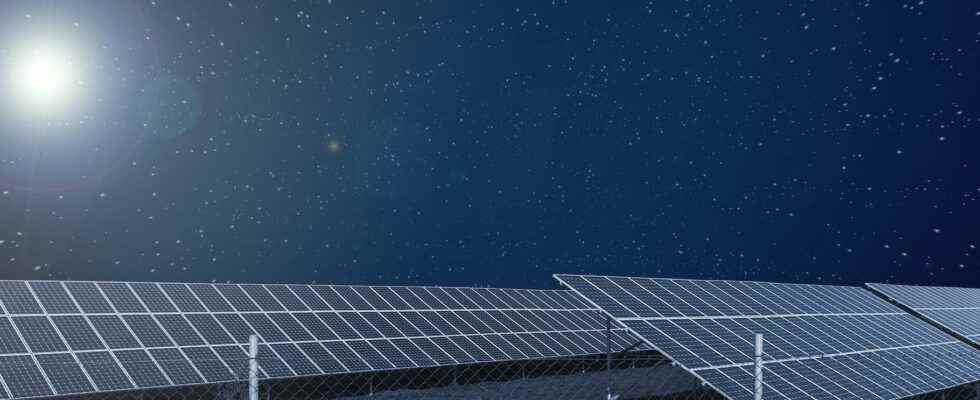Let’s say it right away. The amount of electricity generated is very small. About 100,000 times less than what can be expected from a conventional solar panel. But the idea is perhaps worth considering despite everything. Especially since the University of New South Wales researchers (Australia) hope they can improve the technology. To produceenergy on a much larger scale. This technology is that of generating electricity from a infrared radiation. You know, the one that is emitted by any hot body. Including our human body.
What relationship with thesolar energy ? It is that the day, the light of sunwarms our Earth. In response, at night, it cools by emitting radiation infrared. Exploiting this infrared radiation to produce electricity therefore comes down — indirectly, of course, but all the same — to drawing electricity from our Sun… in the middle of the night. And all of this, here, with a component that is already found in so-called night vision .
“Just as a solar cell can generate electricity by absorbing sunlight emitted during the day, our thermoradiative diode generates electricity from infrared light emitted in a cooler environment at night. In both cases, it is the temperature difference that allows us to produce electricity”says Phoebe Pearce, a researcher at the University of New South Wales, in a communicated.
Power medical devices
To understand, we must remember that when a material is heated, atoms who constitute it are agitated. Their electronsalso. The phenomenon is slight. So to channel this agitation and transform it into a useful current of electrons, researchers at the University of New South Wales had the idea of using a diode. Here, a diode made of tellurium of mercuryand of cadmium . And in their experiments conducted, such a device was shown to be capable of exploiting a temperature difference between the ground and theair of about 12.5°C — a temperature difference quite typical, at night — to generate 2.26 milliwatts of energy per square meter. It seems little.
But the researchers point out that, in the 1950s, the first solar cell had an efficiency that did not exceed 2%. Today, the best performers achieve yields of 23%. On the same model, by taking advantage of the knowledge already acquired in the field and by borrowing materials from the designers of mid-infrared photodetectors, they hope to rapidly advance their new technology. Today, it displays an efficiency of about… 2%. They intend to succeed, in the future, to reach the 1/10and energy that can be produced by conventional solar cells.
The aim would be to focus on the appswho could benefit the most from this way of generating electricity. Powering medical devices, for example. Because the human body also radiates in the infrared. Thus the researchers envision that their technology could recover this energy and transform it into electricity to power a pacemaker . Typically the kind of application for which conventional solar energy could not be used.
Solar panels that generate electricity at night
Solar panels have the major disadvantage that they can only produce electricity when the sun is shining. But researchers have imagined a system that would generate energy even after dark, a kind of solar cell at night.
Article of Nathalie Mayerpublished on 08/02/2020
Solar panels only produce electricity when the Sun shines . This is obvious and moreover one of their weak points. But researchers from the University of California at Davis (USA) claim today to have designed a kind of inverted solar cell, capable of generating up to 50 wattsof energy per square meter in ideal nighttime conditions. That is, according to them, all the same a quarter of the daily production capacity of a conventional solar panel.
What the researchers exploit here is the propensity of hot objects in relation to their environment to emit heat in the form of infrared radiation . In this case, they are using our Earth as a source of heat and the night sky as a dissipator. Because space is a particularly cold place. And by pointing an object towards the sky, it will radiate heat.
A system capable of producing 24 hours a day
Thermoradiative cells, on the other hand, generate energy by radiating heat to their surroundings. Usually, we think of it to recover waste heat in engines, for example. “We imagined that by placing such a cell in a warm place and pointing it towards the sky, we would obtain a system that would generate energy by emitting heat”explains Jeremy Munday, a researcher, in a press release from the University of California at Davis.
According to him, the materials used are different, but the physicalis the same as that which is at stake in conventional photovoltaic panels. And then, the system could work 24/24 provided, during the day, to keep it sheltered from the sun. An interesting solution to counter the intermittent aspect that we thought was inherent to the solar power generation .
The Universe, a new source of renewable energy?
By directing a diode at semiconductorinfrared to the sky, researchers say they will soon be able to generate electricity at night. All from sorts of “inverted solar panels” that will exploit the temperature differences between the Earth and theUniverse .
Article by Nathalie Mayer published on 07/05/2019
New source of energy.
” L’vastness of the universeis a resource thermodynamics . » This is according to Shanhui Fan, a researcher at Stanford University (USA). With his team, he thus affirms that it is possible to generate a measurable quantity of electricity thanks to the cold that reigns in the universe. Or more precisely, thanks to the temperature difference that exists between our Earth and space. A news renewable energy source ?
The photovoltaic solar panels produce electricity from the energy sent to Earth by the Sun. The idea of Shanhui Fan and his colleagues: to capture the energy in the form of heat that continuously leaves the surface of our planet using an infrared semiconductor photodiode directed towards the sky.
A technology in its infancy
To do this, you still need a significant temperature difference. And that’s what the researchers found by pointing their system at space. “But we are far from having obtained results approaching what the theory predicts”tempers another researcher, Masashi Ono.
To give us a concrete idea, they indicate that they are able today to generate 64 nanowatts per square meter from such an “inverted solar panel”. Results that the researchers hope to boost by working on the properties optoelectronicsquantum of their materials. The theory indeed predicts that it should be possible to reach 4 watts per square meter. This remains low compared to solar panels which generate 100 to 200 watts per square meter.
Right now, receive the Mag Futura for free by subscribing to our subscriptions!
Did you know that you can access Futura without ads via our subscriptions?
At the moment, you can discover this advantage with our special offer: subscribe to the “I participate in the life of Futura” (for a minimum of 3 months) and receive the Mag Futura at home* (worth €19)!
*Mag Futura is sent after the third month of registration.
Interested in what you just read?

